Bob Marley
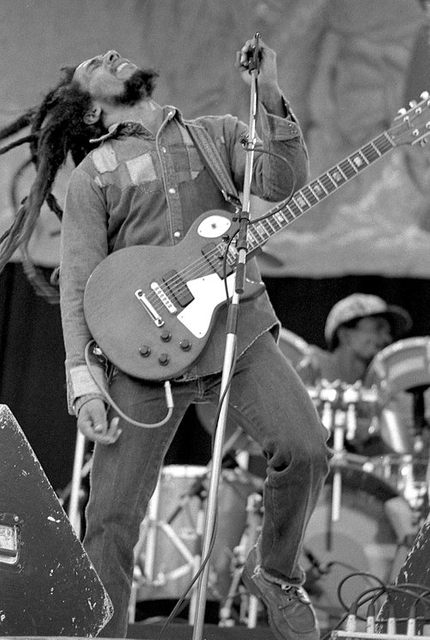
Bob Marley

| Born | |
|---|---|
| Died | 11 May 1981(aged 36) |
| Cause of death | Melanoma(skin cancer) |
| Other names | |
| Occupation | |
| Home town | Trenchtown, Kingston, Jamaica |
| Children | |
| Parent(s) | |
| Relatives | |
| Musical career | |
| Genres | |
| Instruments | |
| 1962–1981 | |
| Labels | |
| Bob Marley and the Wailers | |
| Website | |
Robert Nesta Marley, OM (6 February 1945 – 11 May 1981) was a Jamaican singer and songwriter. Considered one of the pioneers of reggae, his musical career was marked by blending elements of reggae, ska, and rocksteady, as well as forging a smooth and distinctive vocal and songwriting style.[2][3] Marley's contributions to music increased the visibility of Jamaican music worldwide, and made him a global figure in popular culture for over a decade.[4][5]
Born in Nine Mile, British Jamaica, Marley began his professional musical career in 1963, after forming Bob Marley and the Wailers. The group released its debut studio album The Wailing Wailers in 1965, which contained the single "One Love/People Get Ready"; the song was immensely popular, peaking in the top five on worldwide music charts, and established the group as a rising figure in reggae.[6] The Wailers subsequently released eleven further studio albums; while initially employing louder instrumentation and singing, the group began engaging in rhythmic-based song construction in the late 1960s and early 1970s, which coincided with the singer's conversion to Rastafarianism. During this period Marley relocated to London, and the group typified their musical shift with the release of the album The Best of The Wailers (1971).[7]
The group attained international success after the release of the albums Catch a Fire and Burnin' (both 1973), and forged a reputation as touring artists. A year later the Wailers disbanded, and Marley went on to release his solo material under the band's name.[8] His debut studio album Natty Dread (1974) received positive reception, as did its follow-up Rastaman Vibration (1976). A few months after the album's release Marley survived an assassination attempt at his home in Jamaica, which prompted him to permanently relocate to London soon afterward. There he recorded the album Exodus (1977); it incorporated elements of blues, soul, and British rock, enjoyed widespread commercial success, and is widely considered one of the best albums of all time.
Over the course of his career Marley became known as a Rastafari icon, and the singer sought to infuse his music with a sense of spirituality.[9] He is also considered a global symbol of Jamaican culture and identity, and was controversial in his outspoken support for the legalization of marijuana, while he also advocated for Pan-Africanism.[10]
In 1977, Marley was diagnosed with acral lentiginous melanoma; he died as a result of the illness in 1981. His fans around the world expressed their grief, and he received a state funeral in Jamaica. The greatest hits album Legend was released in 1984, and subsequently became the best-selling reggae album of all-time.[11] Marley also ranks as one of the best-selling music artists of all-time, with estimated sales of more than 75 million records worldwide,[12] while his sound and style have influenced artists of various genres. He was posthumously honored by Jamaica soon after his death, as he was designated the nation's Order of Merit award.
| Born | |
|---|---|
| Died | 11 May 1981(aged 36) |
| Cause of death | Melanoma(skin cancer) |
| Other names | |
| Occupation | |
| Home town | Trenchtown, Kingston, Jamaica |
| Children | |
| Parent(s) | |
| Relatives | |
| Musical career | |
| Genres | |
| Instruments | |
| 1962–1981 | |
| Labels | |
| Bob Marley and the Wailers | |
| Website | |
Early life and career
Bob Marley was born on 6 February 1945 at the farm of his maternal grandfather in Nine Mile, Saint Ann Parish, Jamaica, to Norval Sinclair Marley and Cedella Booker.[13] Norval Marley was a white Jamaican originally from Sussex, whose family claimed to have Syrian Jewish origins.[14][15][16] Norval claimed to have been a captain in the Royal Marines;[17] at the time of his marriage to Cedella Booker, an Afro-Jamaican then 18 years old, he was employed as a plantation overseer.[17][18] Bob Marley's full name is Robert Nesta Marley, though some sources give his birth name as Nesta Robert Marley, with a story that when Marley was still a boy a Jamaican passport official reversed his first and middle names because Nesta sounded like a girl's name.[19][20] Norval provided financial support for his wife and child but seldom saw them as he was often away. Bob Marley attended Stepney Primary and Junior High School which serves the catchment area of Saint Ann.[21][22] In 1955, when Bob Marley was 10 years old, his father died of a heart attack at the age of 70.[23] Marley's mother went on to marry Edward Booker, a civil servant from the United States, giving Marley two half-brothers: Richard and Anthony.[24][25]
Marley and Neville Livingston (later known as Bunny Wailer) had been childhood friends in Nine Mile. They had started to play music together while at Stepney Primary and Junior High School.[26] Marley left Nine Mile with his mother when he was 12 and moved to Trenchtown, Kingston. Cedella Booker and Thadeus Livingston (Bunny Wailer's father) had a daughter together whom they named Claudette Pearl,[27] who was a younger sister to both Bob and Bunny. Now that Marley and Livingston were living together in the same house in Trenchtown, their musical explorations deepened to include the latest R&B from United States radio stations whose broadcasts reached Jamaica, and the new ska music.[28] The move to Trenchtown was proving to be fortuitous, and Marley soon found himself in a vocal group with Bunny Wailer, Peter Tosh, Beverley Kelso and Junior Braithwaite. Joe Higgs, who was part of the successful vocal act Higgs and Wilson, resided on 3rd St., and his singing partner Roy Wilson had been raised by the grandmother of Junior Braithwaite. Higgs and Wilson would rehearse at the back of the houses between 2nd and 3rd Streets, and it wasn't long before Marley (now residing on 2nd St.), Junior Braithwaite and the others were congregating around this successful duo.[29] Marley and the others did not play any instruments at this time, and were more interested in being a vocal harmony group. Higgs was glad to help them develop their vocal harmonies, although more importantly, he had started to teach Marley how to play guitar—thereby creating the bedrock that would later allow Marley to construct some of the biggest-selling reggae songs in the history of the genre.[30][31]
Musical career
1962–72: Early years
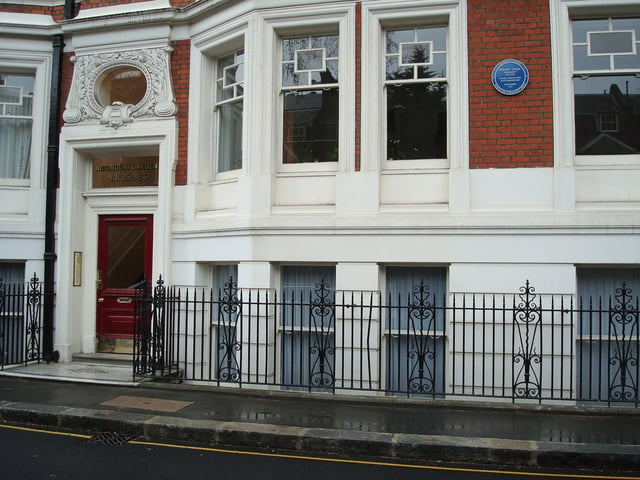
Bob Marley's flat in 1972 at 34 Ridgmount Gardens, Bloomsbury, London
In February 1962, Marley recorded four songs, "Judge Not", "One Cup of Coffee", "Do You Still Love Me?" and "Terror", at Federal Studios for local music producer Leslie Kong.[32] Three of the songs were released on Beverley's with "One Cup of Coffee" being released under the pseudonym Bobby Martell.[33]
In 1963, Bob Marley, Bunny Wailer, Peter Tosh, Junior Braithwaite, Beverley Kelso, and Cherry Smith were called the Teenagers. They later changed the name to the Wailing Rudeboys, then to the Wailing Wailers, at which point they were discovered by record producer Coxsone Dodd, and finally to the Wailers. Their single "Simmer Down" for the Coxsone label became a Jamaican #1 in February 1964 selling an estimated 70,000 copies.[12] The Wailers, now regularly recording for Studio One, found themselves working with established Jamaican musicians such as Ernest Ranglin (arranger "It Hurts To Be Alone"),[35] the keyboardist Jackie Mittoo and saxophonist Roland Alphonso. By 1966, Braithwaite, Kelso, and Smith had left the Wailers, leaving the core trio of Bob Marley, Bunny Wailer, and Peter Tosh.[36]
Though raised as a Catholic, Marley became interested in Rastafari beliefs in the 1960s, when away from his mother's influence.[38] After returning to Jamaica, Marley formally converted to Rastafari and began to grow dreadlocks.
After a financial disagreement with Dodd, Marley and his band teamed up with Lee "Scratch" Perry and his studio band, the Upsetters. Although the alliance lasted less than a year, they recorded what many consider the Wailers' finest work. Marley and Perry split after a dispute regarding the assignment of recording rights, but they would continue to work together.[39]
1969 brought another change to Jamaican popular music in which the beat slowed down even further.
The new beat was a slow, steady, ticking rhythm that was first heard on The Maytals song "Do the Reggay." Marley approached producer Leslie Kong, who was regarded as one of the major developers of the reggae sound. For the recordings, Kong combined the Wailers with his studio musicians called Beverley's All-Stars, which consisted of the bassists Lloyd Parks and Jackie Jackson, the drummer Paul Douglas, the keyboard players Gladstone Anderson and Winston Wright, and the guitarists Rad Bryan, Lynn Taitt, and Hux Brown.[40] As David Moskowitz writes, "The tracks recorded in this session illustrated the Wailers' earliest efforts in the new reggae style. Gone are the ska trumpets and saxophones of the earlier songs, with instrumental breaks now being played by the electric guitar." The songs recorded would be released as the album The Best of The Wailers, including tracks "Soul Shakedown Party," "Stop That Train," "Caution," "Go Tell It on the Mountain," "Soon Come," "Can't You See," "Soul Captives," "Cheer Up," "Back Out," and "Do It Twice".[40]
Between 1968 and 1972, Bob and Rita Marley, Peter Tosh and Bunny Wailer re-cut some old tracks with JAD Records in Kingston and London in an attempt to commercialise the Wailers' sound. Bunny later asserted that these songs "should never be released on an album... they were just demos for record companies to listen to". In 1968, Bob and Rita visited songwriter Jimmy Norman at his apartment in the Bronx. Norman had written the extended lyrics for Kai Winding's "Time Is on My Side" (covered by the Rolling Stones) and had also written for Johnny Nash and Jimi Hendrix.[41] A three-day jam session with Norman and others, including Norman's co-writer Al Pyfrom, resulted in a 24-minute tape of Marley performing several of his own and Norman-Pyfrom's compositions. This tape is, according to Reggae archivist Roger Steffens, rare in that it was influenced by pop rather than reggae, as part of an effort to break Marley into the US charts.[41] According to an article in The New York Times, Marley experimented on the tape with different sounds, adopting a doo-wop style on "Stay With Me" and "the slow love song style of 1960s artists" on "Splish for My Splash".[41] An artist yet to establish himself outside his native Jamaica, Marley lived in Ridgmount Gardens, Bloomsbury, during 1972.[42]
1972–74: Move to Island Records
In 1972, Bob Marley signed with CBS Records in London and embarked on a UK tour with soul singer Johnny Nash.[43] While in London the Wailers asked their road manager Brent Clarke to introduce them to Chris Blackwell, who had licensed some of their Coxsone releases for his Island Records. The Wailers intended to discuss the royalties associated with these releases; instead, the meeting resulted in the offer of an advance of £4,000 to record an album.[44] Since Jimmy Cliff, Island's top reggae star, had recently left the label, Blackwell was primed for a replacement. In Marley, Blackwell recognised the elements needed to snare the rock audience: "I was dealing with rock music, which was really rebel music. I felt that would really be the way to break Jamaican music. But you needed someone who could be that image. When Bob walked in he really was that image."[45] The Wailers returned to Jamaica to record at Harry J's in Kingston, which resulted in the album Catch a Fire
Primarily recorded on an eight-track, Catch a Fire marked the first time a reggae band had access to a state-of-the-art studio and were accorded the same care as their rock 'n' roll peers.[45] Blackwell desired to create "more of a drifting, hypnotic-type feel than a reggae rhythm",[46] and restructured Marley's mixes and arrangements. Marley travelled to London to supervise Blackwell's overdubbing of the album which included tempering the mix from the bass-heavy sound of Jamaican music and omitting two tracks.[45]
The Wailers' first album for Island, Catch a Fire, was released worldwide in April 1973, packaged like a rock record with a unique Zippo lighter lift-top. Initially selling 14,000 units, it didn't make Marley a star, but received a positive critical reception.[45] It was followed later that year by the album Burnin' which included the song "I Shot the Sheriff". Eric Clapton was given the album by his guitarist George Terry in the hope that he would enjoy it.[47] Clapton was suitably impressed and chose to record a cover version of "I Shot the Sheriff" which became his first US hit since "Layla" two years earlier and reached number 1 on the Billboard Hot 100 on 14 September 1974.[12] Many Jamaicans were not keen on the new reggae sound on Catch a Fire, but the Trenchtown style of Burnin found fans across both reggae and rock audiences.[45]
During this period, Blackwell gifted his Kingston residence and company headquarters at 56 Hope Road (then known as Island House) to Marley.
Housing Tuff Gong Studios, the property became not only Marley's office but also his home.[45]
The Wailers were scheduled to open 17 shows in the US for Sly and the Family Stone. After four shows, the band was fired because they were more popular than the acts they were opening for.[49] The Wailers disbanded in 1974, with each of the three main members pursuing a solo career.
1974–76: Line-up changes and shooting
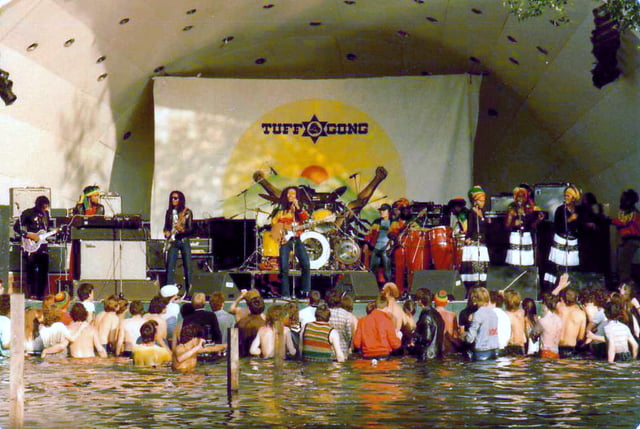
Bob Marley & the Wailers live at Crystal Palace Park in south-east London, during the Uprising Tour
Despite the break-up, Marley continued recording as "Bob Marley & The Wailers".
His new backing band included brothers Carlton and Aston "Family Man" Barrett on drums and bass respectively, Junior Marvin and Al Anderson on lead guitar, Tyrone Downie and Earl "Wya" Lindo on keyboards, and Alvin "Seeco" Patterson on percussion. The "I Threes", consisting of Judy Mowatt, Marcia Griffiths, and Marley's wife, Rita, provided backing vocals. In 1975, Marley had his international breakthrough with his first hit outside Jamaica, "No Woman, No Cry", from the Natty Dread album.[12] This was followed by his breakthrough album in the United States, Rastaman Vibration (1976), which reached the Top 50 of the Billboard Soul Charts.[12]
On 3 December 1976, two days before "Smile Jamaica", a free concert organised by the Jamaican Prime Minister Michael Manley in an attempt to ease tension between two warring political groups, Marley, his wife, and manager Don Taylor were wounded in an assault by unknown gunmen inside Marley's home. Taylor and Marley's wife sustained serious injuries but later made full recoveries. Bob Marley received minor wounds in the chest and arm.[52] The attempt on his life was thought to have been politically motivated, as many felt the concert was really a support rally for Manley. Nonetheless, the concert proceeded, and an injured Marley performed as scheduled, two days after the attempt. When asked why, Marley responded, "The people who are trying to make this world worse aren't taking a day off. How can I?" The members of the group Zap Pow played as Bob Marley's backup band before a festival crowd of 80,000 while members of The Wailers were still missing or in hiding.[53][54]
1976–79: Relocation to England
Marley left Jamaica at the end of 1976, and after a month-long "recovery and writing" sojourn at the site of Chris Blackwell's Compass Point Studios in Nassau, Bahamas, arrived in England, where he spent two years in self-imposed exile.
Whilst in England, he recorded the albums Exodus and Kaya. Exodus stayed on the British album charts for 56 consecutive weeks. It included four UK hit singles: "Exodus", "Waiting in Vain", "Jamming", and "One Love" (a rendition of Curtis Mayfield's hit, "People Get Ready"). During his time in London, he was arrested and received a conviction for possession of a small quantity of cannabis.[55] In 1978, Marley returned to Jamaica and performed at another political concert, the One Love Peace Concert, again in an effort to calm warring parties. Near the end of the performance, by Marley's request, Michael Manley (leader of then-ruling People's National Party) and his political rival Edward Seaga (leader of the opposing Jamaica Labour Party), joined each other on stage and shook hands.[56]
Under the name Bob Marley and the Wailers 11 albums were released, four live albums and seven studio albums.
The releases included Babylon by Bus, a double live album with 13 tracks, were released in 1978 and received critical acclaim. This album, and specifically the final track "Jamming" with the audience in a frenzy captured the intensity of Marley's live performances.[57]
"Marley wasn't singing about how peace could come easily to the World but rather how hell on Earth comes too easily to too many.
His songs were his memories; he had lived with the wretched, he had seen the downpressers and those whom they pressed down."
– Mikal Gilmore, Rolling Stone[58]
1979–81: Later years
Survival, a defiant and politically charged album, was released in 1979. Tracks such as "Zimbabwe", "Africa Unite", "Wake Up and Live", and "Survival" reflected Marley's support for the struggles of Africans. His appearance at the Amandla Festival in Boston in July 1979 showed his strong opposition to South African apartheid, which he already had shown in his song "War" in 1976. In early 1980, he was invited to perform at 17 April celebration of Zimbabwe's Independence Day.[59]
Uprising (1980) was Bob Marley's final studio album, and is one of his most religious productions; it includes "Redemption Song" and "Forever Loving Jah".[60] Confrontation, released posthumously in 1983, contained unreleased material recorded during Marley's lifetime, including the hit "Buffalo Soldier" and new mixes of singles previously only available in Jamaica.[61]
Illness and death
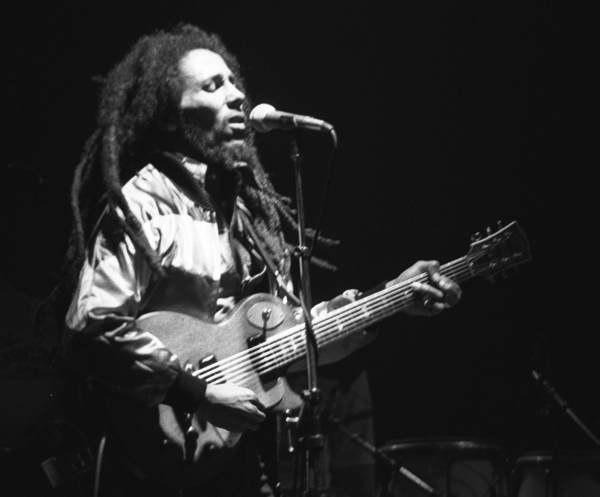
Marley in concert in 1980, Zürich, Switzerland
In July 1977, Marley was found to have a type of malignant melanoma under the nail of a toe. Contrary to urban legend, this lesion was not primarily caused by an injury during a football match that year but was instead a symptom of already-existing cancer. Marley turned down his doctors' advice to have his toe amputated (which would have hindered his performing career), citing his religious beliefs, and instead, the nail and nail bed were removed and a skin graft was taken from his thigh to cover the area.[62][63] Despite his illness, he continued touring and was in the process of scheduling a world tour in 1980.[64]
The album Uprising was released in May 1980. The band completed a major tour of Europe, where it played its biggest concert to 100,000 people in Milan. After the tour, Marley went to the United States, where he performed two shows at Madison Square Garden in New York City as part of the Uprising Tour.[65]
Marley's last concert occurred at the Stanley Theater (now called The Benedum Center For The Performing Arts) in Pittsburgh, Pennsylvania, on 23 September 1980. Just two days earlier he had collapsed during a jogging tour in Central Park and was brought to the hospital where he learned that his cancer had spread to his brain.[66]
The only known photographs from the show were featured in Kevin Macdonald's documentary film Marley.[67]
Shortly afterward, Marley's health deteriorated as his cancer had spread throughout his body. The rest of the tour was canceled and Marley sought treatment at the Bavarian clinic of Josef Issels, where he received an alternative cancer treatment called Issels treatment partly based on avoidance of certain foods, drinks, and other substances. After eight months of effectively failing to treat his advancing cancer Marley boarded a plane for his home in Jamaica.[68]
While Marley was flying home from Germany to Jamaica, his vital functions worsened.
After landing in Miami, Florida, he was taken to the hospital for immediate medical attention. Marley died on 11 May 1981 at Cedars of Lebanon Hospital in Miami (now University of Miami Hospital), aged 36. The spread of melanoma to his lungs and brain caused his death. His final words to his son Ziggy were "Money can't buy life."[69]
On 21 May 1981, Jamaican Prime Minister Edward Seaga delivered the final funeral eulogy to Marley, declaring:
His voice was an omnipresent cry in our electronic world.
His sharp features, majestic looks, and prancing style a vivid etching on the landscape of our minds.
Bob Marley was never seen.
He was an experience which left an indelible imprint with each encounter.
Such a man cannot be erased from the mind.
He is part of the collective consciousness of the nation.[58]
Legacy
Awards and honours
1976: Rolling Stone
June 1978: Awarded the Peace Medal of the Third World from the United Nations.[58]
February 1981: Awarded the Jamaican Order of Merit, then the nation's third highest honour,.[75]
March 1994: Inducted into the Rock and Roll Hall of Fame.
1999: Album of the Century for Exodus by Time Magazine.[76]
February 2001: A star on the Hollywood Walk of Fame.
February 2001: Awarded Grammy Lifetime Achievement Award.[77]
2004: Rolling Stone ranked him No. 11 on their list of the 100 Greatest Artists of All Time.[78]
2004: Among the first inductees into the UK Music Hall of Fame
"One Love" named song of the millennium by BBC.
Voted as one of the greatest lyricists of all time by a BBC poll.[79]
2006: A blue plaque was unveiled at his first UK residence in Ridgmount Gardens, London, dedicated to him by the Nubian Jak Community Trust and supported by Her Majesty's Foreign Office.[80][81]
2010: Catch a Fire inducted into the Grammy Hall of Fame (Reggae Album).[82]
Other tributes
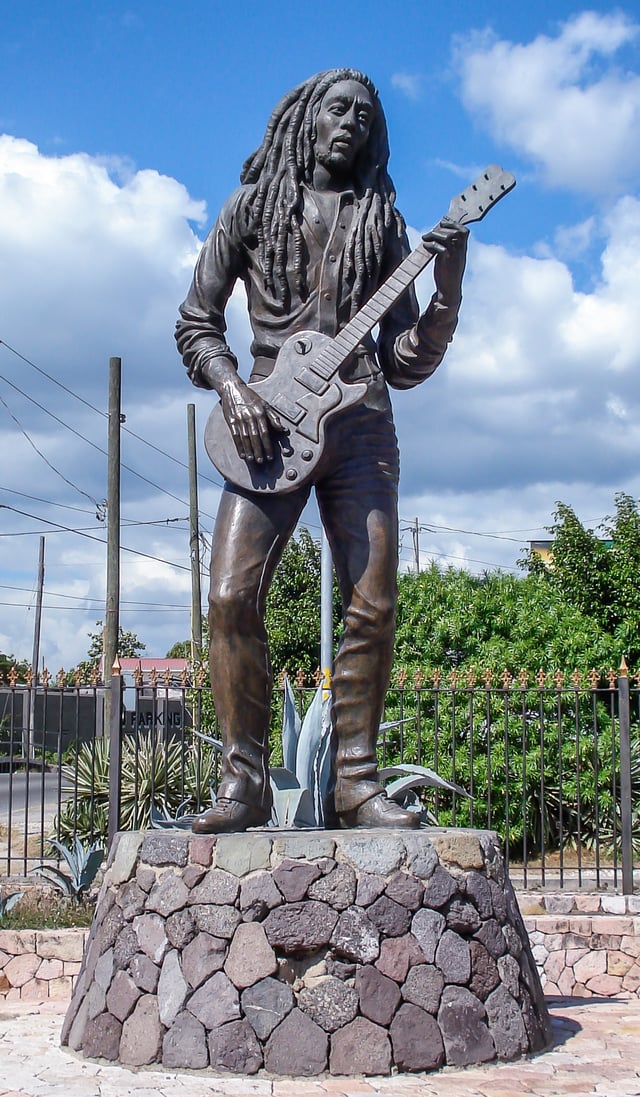
Marley statue in Kingston
A statue was inaugurated, next to the national stadium on Arthur Wint Drive in Kingston to commemorate him.[83] In 2006, the New York City Department of Education co-named a portion of Church Avenue from Remsen Avenue to East 98th Street in the East Flatbush section of Brooklyn as "Bob Marley Boulevard".[84][85] In 2008, a statue of Marley was inaugurated in Banatski Sokolac, Serbia.[86]
Internationally, Marley's message also continues to reverberate among various indigenous communities. For instance, the Australian Aboriginal people continue to burn a sacred flame to honour his memory in Sydney's Victoria Park, while members of the Amerindian Hopi and Havasupai tribe revere his work.[58] There are also many tributes to Bob Marley throughout India, including restaurants, hotels, and cultural festivals.[87][88]
Marley evolved into a global symbol, which has been endlessly merchandised through a variety of mediums.
In light of this, author Dave Thompson in his book Reggae and Caribbean Music, laments what he perceives to be the commercialised pacification of Marley's more militant edge, stating:
Bob Marley ranks among both the most popular and the most misunderstood figures in modern culture...
That the machine has utterly emasculated Marley is beyond doubt.
Gone from the public record is the ghetto kid who dreamed of Che Guevara and the Black Panthers, and pinned their posters up in the Wailers Soul Shack record store; who believed in freedom; and the fighting which it necessitated, and dressed the part on an early album sleeve; whose heroes were James Brown and Muhammad Ali; whose God was Ras Tafari and whose sacrament was marijuana. Instead, the Bob Marley who surveys his kingdom today is smiling benevolence, a shining sun, a waving palm tree, and a string of hits which tumble out of polite radio like candy from a gumball machine. Of course it has assured his immortality. But it has also demeaned him beyond recognition. Bob Marley was worth far more.[89]
Several film adaptations have evolved as well.
For instance, a feature-length documentary about his life, Rebel Music, won various awards at the Grammys. With contributions from Rita, The Wailers, and Marley's lovers and children, it also tells much of the story in his own words.[90] In February 2008, director Martin Scorsese announced his intention to produce a documentary movie on Marley. The film was set to be released on 6 February 2010, on what would have been Marley's 65th birthday.[91] However, Scorsese dropped out due to scheduling problems. He was replaced by Jonathan Demme,[92] who dropped out due to creative differences with producer Steve Bing during the beginning of editing. Kevin Macdonald replaced Demme[93] and the film, Marley, was released on 20 April 2012.[94] In 2011, ex-girlfriend and filmmaker Esther Anderson, along with Gian Godoy, made the documentary Bob Marley: The Making of a Legend, which premiered at the Edinburgh International Film Festival.[95]
In October 2015, Jamaican author Marlon James' novel A Brief History of Seven Killings, a fictional account of the attempted assassination of Marley, won the 2015 Man Booker Prize at a ceremony in London.[96]
Personal life
Religion
Bob Marley was a member for some years of the Rastafari movement, whose culture was a key element in the development of reggae. He became an ardent proponent of Rastafari, taking its music out of the socially deprived areas of Jamaica and onto the international music scene. He once gave the following response, which was typical, to a question put to him during a recorded interview:
Interviewer: "Can you tell the people what it means being a Rastafarian?" Marley: "I would say to the people, Be still, and know that His Imperial Majesty, Emperor Haile Selassie of Ethiopia is the Almighty. Now, the Bible seh so, Babylon newspaper seh so, and I and I the children seh so. Yunno? So I don't see how much more reveal our people want. Wha' dem want? a white god, well God come black. True true."[97]
Family
Bob Marley married Alpharita Constantia "Rita" Anderson in Kingston, Jamaica, on 10 February 1966.[100] Marley had many children: four with his wife Rita, two adopted from Rita's previous relationships, and several others with different women. The Bob Marley official website acknowledges 11 children.
Those listed on the official site are:
Sharon, born 23 November 1964, daughter of Rita from a previous relationship but then adopted by Marley after his marriage with Rita
Cedella born 23 August 1967, to Rita
David "Ziggy", born 17 October 1968, to Rita
Stephen, born 20 April 1972, to Rita
Robert "Robbie", born 16 May 1972, to Pat Williams
Rohan, born 19 May 1972, to Janet Hunt
Karen, born 1973 to Janet Bowen
Stephanie, born 17 August 1974; according to Cedella Booker she was the daughter of Rita and a man called Ital with whom Rita had an affair, nonetheless, she was acknowledged as Bob's daughter
Julian, born 4 June 1975, to Lucy Pounder
Ky-Mani, born 26 February 1976, to Anita Belnavis
Damian, born 21 July 1978, to Cindy Breakspeare
Other sites have noted additional individuals who claim to be family members,[101] as noted below:
Makeda was born on 30 May 1981, to Yvette Crichton, after Marley's death.[102] Meredith Dixon's book lists her as Marley's child, but she is not listed as such on the Bob Marley official website.
Various websites, for example,[103] also list Imani Carole, born 22 May 1963 to Cheryl Murray; but she does not appear on the official Bob Marley website.[102]
Association football
Aside from music, association football played a major role throughout his life.[104] As well as playing the game, in parking lots, fields, and even inside recording studios, growing up he followed the Brazilian club Santos and its star player Pelé.[104] Marley surrounded himself with people from the sport, and in the 1970s made the Jamaican international footballer Allan "Skill" Cole his tour manager.[104] He told a journalist, "If you want to get to know me, you will have to play football against me and the Wailers."[104]
Personal views
Pan-Africanism
Marley was a Pan-Africanist and believed in the unity of African people worldwide. His beliefs were rooted in his Rastafari religious beliefs.[105] He was substantially inspired by Marcus Garvey, and had anti-imperialist and pan-Africanist themes in many of his songs, such as "Zimbabwe", "Exodus", "Survival", "Blackman Redemption", and "Redemption Song". "Redemption Song" draws influence from a speech given by Marcus Garvey in Nova Scotia, 1937.[106] Marley held that independence of African countries from European domination was a victory for all those in the African diaspora. In the song "Africa Unite", he sings of a desire for all peoples of the African diaspora to come together and fight against "Babylon"; similarly, in the song "Zimbabwe", he marks the liberation of the whole continent of Africa, and evokes calls for unity between all Africans, both within and outside Africa.[107]
Cannabis
Marley considered cannabis a healing herb, a "sacrament", and an "aid to medication"; he supported the legalisation of the drug.[108][108]Catholicism eing caught with cannabis but continued to use marijuana in accordance with his religious beliefs. Of his marijuana usage, he said, "When you smoke herb, herb reveal yourself to you. All the wickedness you do, the herb reveal itself to yourself, your conscience, show up yourself clear, because herb make you meditate. Is only a natural t'ing and it grow like a tree."[109] Marley saw marijuana usage as a vital factor in religious growth and connection with Jah, and as a way to philosophise and become wiser.[110]
Discography
Studio albums
The Wailing Wailers
Soul Rebels
Soul Revolution
The Best of The Wailers
Catch a Fire
Burnin'
Natty Dread
Rastaman Vibration
Exodus
Kaya
Survival
Uprising
Confrontation
Live albums
Live!
Babylon by Bus
See also
Outline of Bob Marley
List of peace activists
Fabian Marley
Desis bobmarleyi